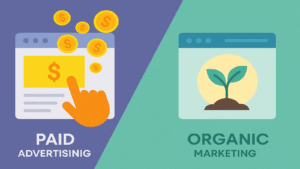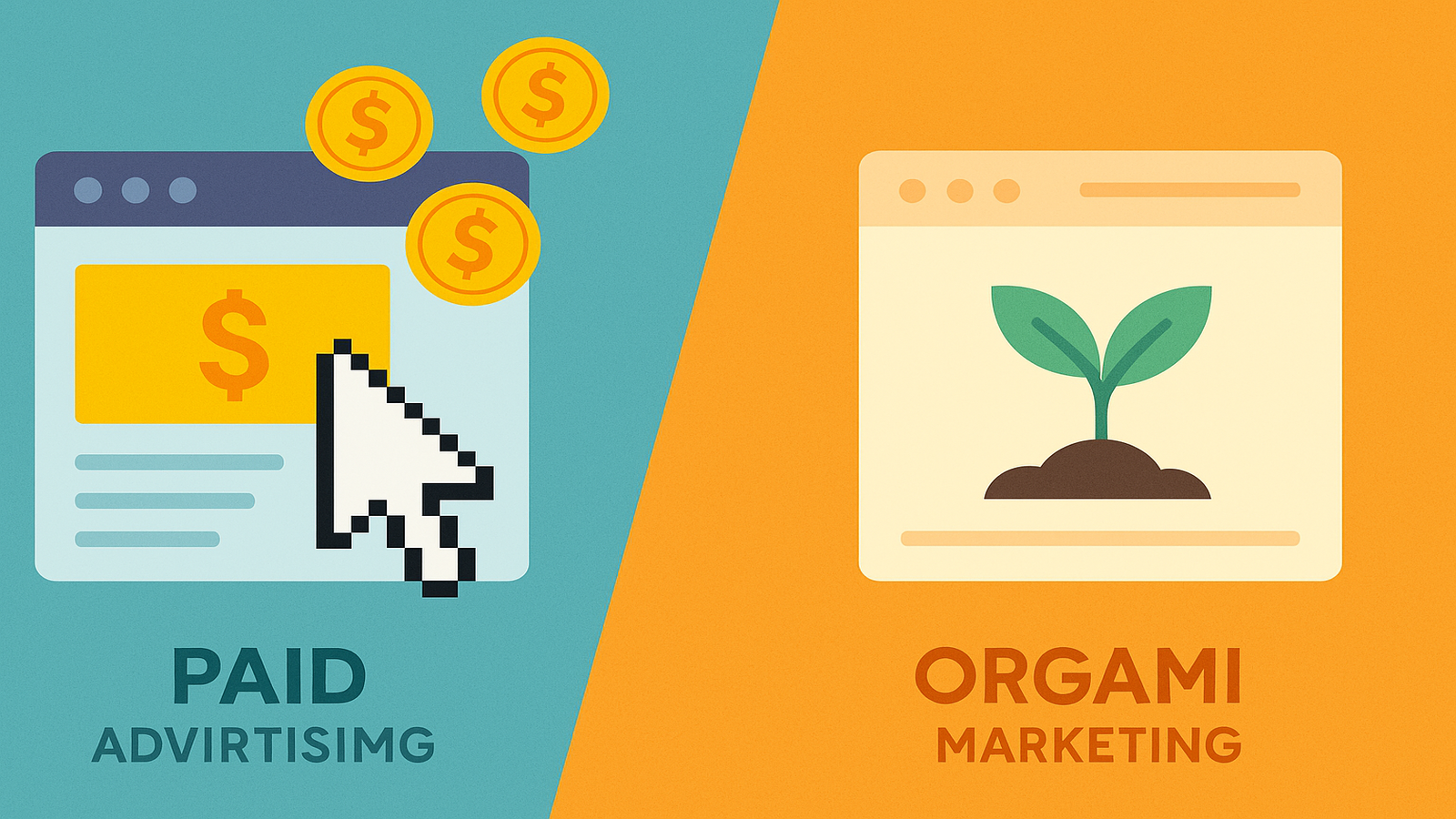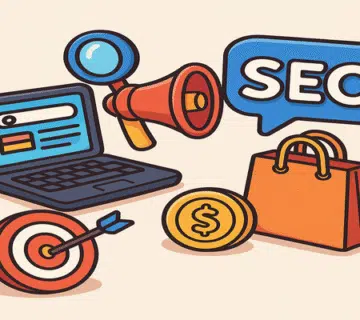Paid Advertising vs. Organic Marketing
Introduction
In the modern business world, paid advertising and organic marketing are two fundamental strategies used by many companies to raise brand awareness and strengthen audience engagement. While paid advertising involves spending money to promote content or products across various platforms, organic marketing relies on natural, authentic efforts to attract customers through valuable content and search engine optimization.
Paid advertising is characterized by providing fast and visible results—companies can see the impact of their campaigns almost immediately. However, such campaigns may require large budgets and their effects may cease once the paid period ends. On the other hand, organic marketing is considered a sustainable approach, helping build long-term relationships with customers by providing content that is valuable and relevant to their needs.
There are fundamental differences between the two methods. For example, paid campaigns target a specific audience directly, whereas organic marketing targets audiences more indirectly through search engine optimization and excellent user experience design. Which strategy is more appropriate depends largely on the business’s needs and specific goals.
If the goal is to achieve fast results and broad reach, paid advertising may be ideal. But if a business aims to build a strong long-term presence and increase loyalty, then organic marketing might be the better choice.

What Is Paid Advertising?
Paid advertising is a form of digital marketing that involves paying to display certain ads on various platforms. These ads can appear on social media platforms such as Facebook, Instagram, and Twitter, as well as on search engines like Google. The goal of paid advertising is to amplify brand awareness and increase engagement with a targeted audience in an efficient way.
Paid ads come in different formats depending on the platform. For example, they may include text ads, display (visual) ads, or email-based ads. Each format requires a different strategy to reach the desired audience, making paid advertising a flexible option that can align with the brand’s marketing objectives.
When considering using paid advertising, it’s crucial to understand how it works and the costs involved. Typically, payment is made based on either Cost Per Click (CPC) or Cost Per Mille (CPM, i.e., cost per thousand impressions). In the CPC model, advertisers pay only when a user clicks the ad, while in the CPM model, they pay when the ad is shown a certain number of times. Costs can vary widely depending on factors such as industry, competition, and targeted keywords.
Evaluating the effectiveness of a paid campaign is essential. Success metrics often include the number of clicks, conversions, and return on investment (ROI). By analyzing these data, advertisers can improve their strategies and achieve better results.
What Is Organic Marketing?
Organic marketing is a strategy that focuses on attracting customers by creating valuable, relevant content rather than relying on paid ads. This type of marketing depends on search engine optimization (SEO) and content marketing techniques to capture attention and raise brand awareness. Organic marketing requires consistency and creativity in delivering content that appeals to your target audience and helps build long-lasting relationships with customers.
SEO is the process of optimizing your website so it appears more prominently in search engine results like Google. This includes using appropriate keywords, improving user experience, and building backlinks. By improving SEO, you can attract organic traffic to your site, which may increase visits and sales without heavy expenditure on advertising.
Additionally, content marketing plays a vital role in organic marketing. It involves creating and distributing helpful, relevant content — such as articles, blogs, videos, and infographics — that address audience needs. By consistently offering valuable content, brands strengthen their position as authorities in their fields, boosting credibility and customer trust.
In the end, organic marketing is an investment in long-term customer relationships. It can yield sustainable results and enhance brand awareness without the high costs associated with paid advertising.
Benefits & Advantages of Paid Advertising
Paid advertising is a powerful and effective tool that helps reinforce brand presence and increase awareness in competitive markets. A key advantage of paid advertising is its ability to reach a targeted audience quickly. Through paid campaigns, companies can define and target precise segments, making it ideal for reaching potential customers quickly and effectively. For instance, a startup can target users actively searching for particular services, thus improving conversion chances.
Furthermore, paid advertising allows for a tangible boost in brand awareness. When products or services are advertised across platforms like social media or search engines, consumers become acquainted with the brand and can engage with it. This heightened awareness fosters trust between the customer and brand, which can motivate further action toward purchase.
Another benefit of paid advertising is the ability to collect data and insights about campaign performance. Through analytics tools, marketers can monitor ad engagement, which gives them a deeper understanding of consumer behavior and market needs. The data derived from these campaigns help refine future strategies and increase campaign effectiveness. For example, a company may use successful campaign data to retarget ads and improve conversion rates.
Benefits & Advantages of Organic Marketing
Organic marketing is an effective, sustainable strategy supporting business growth in the long term. This type of marketing is relatively low-cost compared to paid ads since it relies mainly on SEO and valuable content to attract visitors naturally.
Thus, this strategy allows businesses to save substantial budgets that can be reinvested into other areas, such as improving products or service quality.
Moreover, organic marketing contributes to building strong relationships with customers. By offering high-quality content, companies can attract the attention of their target audience and engage them in a way that fosters loyalty. A customer interacting with organic content often feels part of a larger community connected to the brand, increasing the likelihood of repeat purchases and referrals.
Additionally, organic marketing helps improve the brand’s overall image. When companies show a commitment to providing real value via educational or informational content, public trust in them strengthens. This trust is not just essential for driving sales; it plays a critical role in building a positive brand reputation in the market.
Integrating organic marketing strategies can lead to enhanced brand awareness and new visitor acquisition, making it an attractive and effective option for any entity seeking sustainable success and growth.
Challenges & Drawbacks of Paid Advertising
While paid ads are a common means to promote products and services, they face several challenges and drawbacks that businesses must consider. One prominent challenge is the high cost associated with running advertising campaigns. Paid ads may require large budgets, which can strain startups or small businesses lacking sufficient resources.
Furthermore, paid advertising often requires continuous funding. Once you stop investing in ads, traffic and sales may decline significantly, highlighting the need for sustained investment. This dependence on ongoing funding can be unsustainable over the long run and poses a risk of losing a growing customer base.
Trust and credibility issues may also arise. Consumers sometimes approach paid advertising with caution and may view it skeptically. Many customers prefer decisions based on personal experiences or recommendations from friends, rather than sponsored ads. This dynamic can negatively affect brand perception and push companies to work harder to build long-term credibility with their audience.
Additionally, changes in advertising platform algorithms can lead to unpredictable fluctuations in campaign performance, making stable planning difficult. Maintaining cost-effectiveness in paid advertising is challenging as market conditions and trends can shift rapidly.
Challenges & Drawbacks of Organic Marketing
Though organic marketing offers many benefits, it faces several challenges worth acknowledging. First, building a successful organic marketing strategy demands a significant investment of time and effort. Brands need to produce high-quality content, optimize SEO, and engage continuously with audiences—meaning results won’t appear overnight. Such efforts demand patience and persistence, which can be discouraging for businesses seeking fast results.
Additionally, measuring the effectiveness of organic marketing strategies is another challenge. While paid ads have clear, trackable reports, content marketing and organic efforts often struggle to show immediate, tangible results. Success in organic marketing often requires a longer timeframe to manifest in increased website visits or conversion rates, making it difficult to assess campaign success in the short term.
Organic marketing also faces fierce competition online. As more companies adopt organic strategies, outperforming competitors and achieving high rankings in search results becomes more challenging. SEO optimization demands specialized skills and often requires investment in tools and resources to meet goals.
Overall, despite the challenges of organic marketing, it remains a valuable path for many businesses. Awareness of these challenges allows you to devise strategies to overcome them and succeed in the digital marketing landscape.
How to Choose What Suits Your Business
When it comes to deciding between paid advertising and organic marketing, there are several factors to consider to ensure your decision is sound. A clear understanding of your business goals and available resources is essential in this process. Asking yourself certain questions can help evaluate which strategy fits best.
One important question is: what are your short-term and long-term business goals? If you aim to get fast results, paid advertising may be the better choice. But if you have a long-term vision to build your brand and grow awareness, organic marketing would be more suitable. This approach may take more time, but it contributes to sustainable outcomes.
Also, consider your available budget. Paid advertising can be expensive, so it’s crucial to ensure you have enough resources to execute this strategy effectively. On the other hand, organic marketing may demand more time and effort, but it is often more cost-efficient in the long run.
Audience considerations are also key. The success of any marketing strategy depends heavily on how your audience responds to both paid ads and organic efforts. Study your audience’s behavior to understand which approach suits them better.
By following these steps, you can make an informed decision about the best strategy for your business—whether paid advertising or organic marketing—according to your capacity to meet your goals.
Conclusion
In conclusion, this article has spotlighted the importance of selecting the right marketing strategy for your business—whether paid advertising or organic marketing. It has covered the advantages and disadvantages of both options, helping you gain a deeper understanding of how each influences business growth and audience expansion. Both paid ads and organic marketing play effective roles in reaching customers and boosting brand awareness.
It is also essential to evaluate your business’s unique needs and analyze the targeted market before deciding on the optimal strategy. For example, if you have a limited budget and seek long-term relationships with customers, organic marketing may be ideal. Conversely, if you require fast and effective results, investing in paid advertising may be more suitable.
Moreover, the two strategies can complement each other. You might use paid advertising to attract immediate attention to your services or products, while relying on organic marketing to build trust and loyalty over time. By balancing and integrating these strategies within an overall marketing plan, marketers can achieve better results and increase opportunities for growth and revenue.
Therefore, striking the right balance between paid advertising and organic marketing is crucial in a comprehensive marketing strategy. The ability to combine both methods effectively will strengthen your market position and place you in a more competitive standing.




No comment